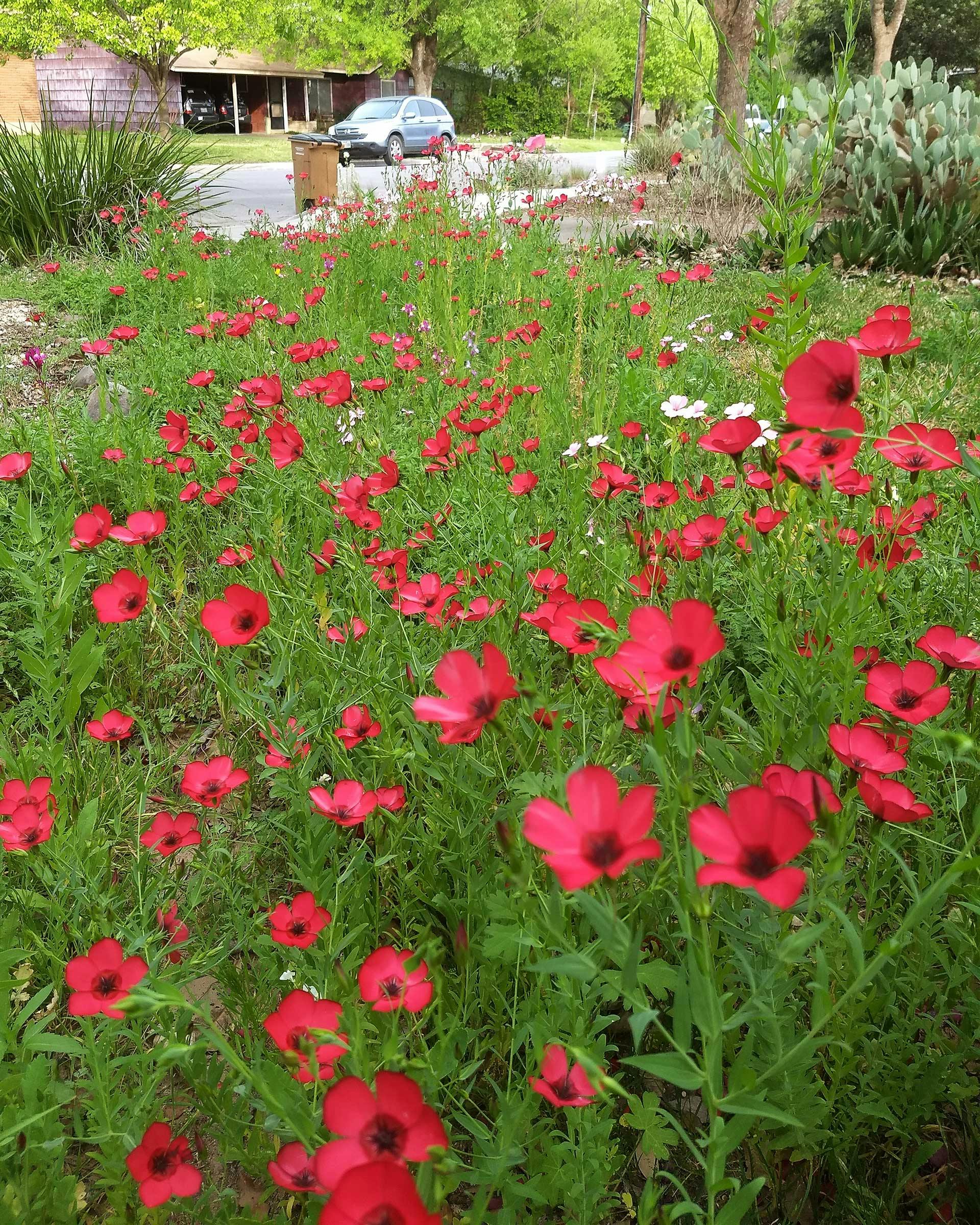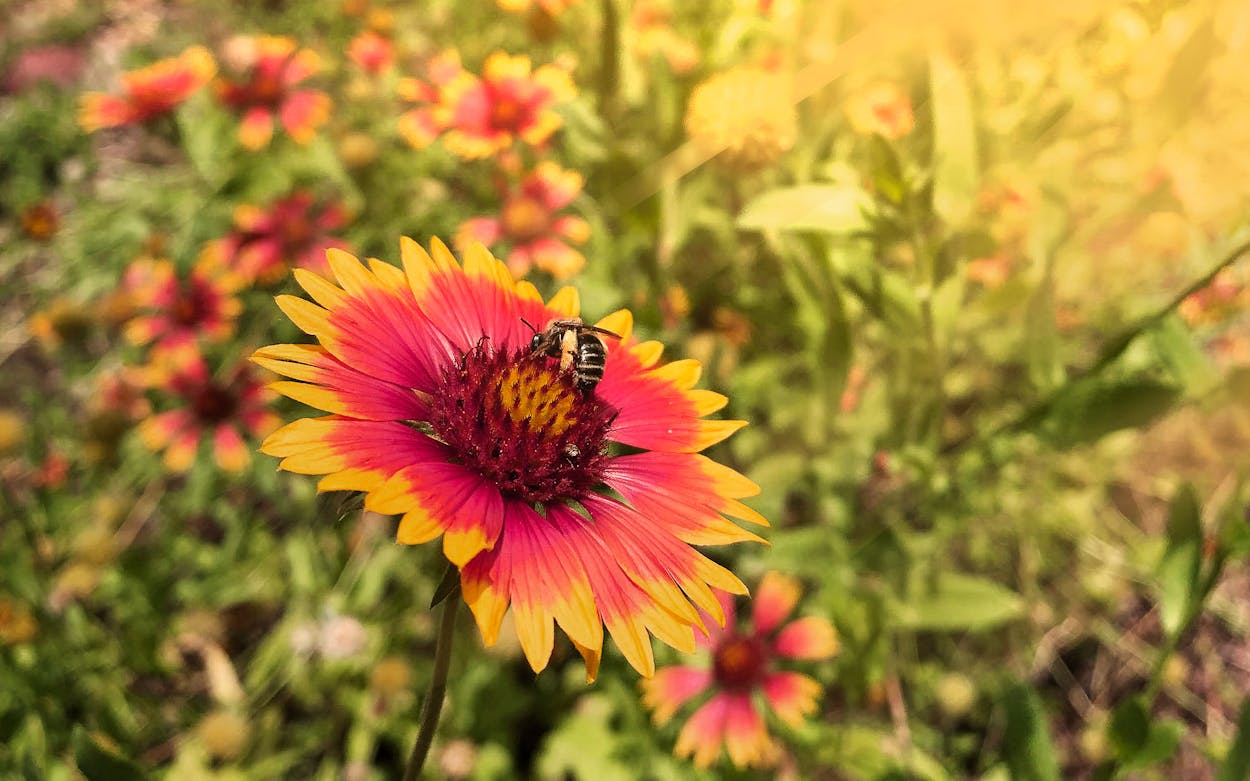One of the delights of gardening is that it allows you to time travel. As the days grow shorter and colder, gardeners aren’t thinking much about the impending pandemic winter. Instead, they’re planning ahead for spring.
Every year, one day in early November, my husband (the primary gardener in our household) opens a drawer to retrieve a small Ziploc bag of fuzzy, light brown bluebonnet seed pods. They’ve been waiting there since June, when we collected them together after that year’s flowers had gone to seed. He pops the tiny seeds out of their pods, then scratches them with sandpaper—a ritual called scarifying (more on that later) that helps the seeds germinate. We scatter them in a sunny patch of the front yard, and then we wait. Little green rosettes appear on the ground after a month or two. They look delicate, almost lacy, and when the first freeze coats the leaves in frost, I always worry. But bluebonnets are cold-hardy, a trait that carries them through the winter to their triumphant bloom in late March and early April. It’s impressive every time.
If you want to put on a similar show in your garden, a little planning ahead will go a long way. “Now is the perfect time to be planting seed for spring-blooming wildflowers,” says Andrea DeLong-Amaya, director of horticulture at the Lady Bird Johnson Wildflower Center in Austin. Wildflowers are forgiving, so the exact timing doesn’t matter much, regardless of where you live in Texas. “If you can get your seeds planted ideally by the end of November, that’s good,” DeLong-Amaya says. “I’ve even planted bluebonnets in January, and they just won’t get as big, but they do fine.”
Planting wildflowers isn’t complicated, but there are a few things to keep in mind. DeLong-Amaya and George Cates, farm manager at Native American Seed in Junction, shared their best advice with Texas Monthly.
Choose a flat, sunny spot (or plan carefully for shade).
Most wildflowers do best in full sun, and a slope could cause issues with drainage or seed clumping. Avoid planting wildflowers under a mature tree or on a steep hill—you’re looking for an area that’s mostly level and that gets lots of light in the winter. But don’t fret if you only have a shady area to work with. In that case, Cates suggests planting a shade-friendly seed mix like the one from Native American Seed, which includes fourteen species in one packet. Not every species will thrive in your yard, and that’s okay. “A mix is nice because it’s a shotgun blast approach, so something’s bound to work,” he says.
For a sunny yard, you can’t go wrong with these hardy classics:
Indian blanket
Lemon mint
Mexican hat
Texas bluebonnet
Prairie coneflower
Cowpen daisy
Huisache daisy
Winecups
Below are a few flowers that love the shade:
Purple coneflower
Pigeonberry
Blue curls
Pitcher sage
Blue mistflower
Turk’s cap
Texas baby blue eyes
Prep the area.
Clear any weeds, mulch, or debris away from your garden bed. Your goal is to disturb the area slightly and allow for direct seed-to-soil contact. “Historically, wildflower meadows were created by fire or by herds of bison that would come in and trample the grass,” Cates says. “Today, that disturbance could be something like mowing, raking, or plowing.”
It’s not necessary to have a totally empty area, but make sure to remove any invasive species—Bermuda grass and bastard cabbage are two frequent offenders—that could crowd out your flowers. Not sure what’s growing in your yard? The wildflower center website has a searchable plant database, as does the U.S. Department of Agriculture. The free iNaturalist app is another excellent resource—simply snap a photo of a plant on your phone, then run it through the app to see possible identifications.
Don’t be scared to scarify.
Most wildflower seeds will sprout happily on their own, but a few species do better with a little help. Bluebonnets and milkweed are two common Texas wildflowers that benefit from scarifying, a process that mimics natural weathering and allows seeds to germinate more easily. Because these plants have very hard seed coatings, the idea is to scratch or otherwise loosen them a little. There are numerous methods, from rubbing the seeds with sandpaper or a brick to scratching them with a rake, and they all work just fine. DeLong-Amaya shares one approach that she’s perfected for bluebonnets: “It sounds crazy, but we’ve had good luck with freezing the seeds for a few days, then putting them in a bowl and pouring boiling water over it. Then let them sit overnight before planting.” The seeds should puff up as they absorb water, loosening the tough exterior coat and allowing the seedling to burst through.
Know your soil.
Sand, loam, clay, and caliche are the four most common soil types, according to Cates. Every plant for sale on the Native American Seed website is accompanied by a simple chart that states which soil types it’ll thrive in. The Texas Almanac also has a color-coded map that shows how widely soil varies across the state. It’s good to get a general idea of which soil type you have, but don’t overthink it. “Most people have sandy loam soil or clay loam soil, and most anything does fine in that,” Cates says. “Wildflowers in general are pretty hardy and will just do their thing.” When in doubt, ask the staff at a local nursery for advice—they’ll know your area best.If you’re planting bluebonnets, DeLong-Amaya offers an additional soil tip. The flowers will grow better if a beneficial bacteria called rhizobium is present in the soil. Inoculating your dirt with the stuff is easy enough. “If you’ve had an area where bluebonnets have grown really well before, take a shovel of that soil and mix it into the new area,” she says. You could also ask a friend or neighbor to share a scoop of soil with you.
Plant carefully.
When it comes time to get the seeds in the ground, refer to the seed packet for instructions. Every species is a little different, but the key is to ensure good seed-to-soil contact. Avoid the common mistake of burying tiny wildflower seeds too deep in the ground—Cates recommends planting them no more than twice as deep as the seeds are wide. Since the seeds are so tiny, it can help to mix them with sand or compost, which will help spread the seedlings out and keep them from sprouting in big clumps. Bluebonnet seeds are nearly identical to decomposed granite, so if you mix those together, hungry birds are less likely to snack on your seeds. Planting can also be a family affair. “The most fun is to do a wildflower stomp, where you gather five kids or grandkids, plant the seeds, and have the kids hop up and down to pack them in,” Cates says.
Embrace the natural look.
Wildflower meadows look a little, well, wild, especially after the flowers are done blooming. This bucks prevailing trends in landscape design, which often emphasizes an orderly, well-groomed appearance. If you live in a neighborhood with a homeowners’ association that restricts what you can grow in your front yard, you might choose to plant wildflowers in the backyard instead. Failing that, an official designation may lend your unruly yard a certain credibility. “Some people have been able to counter complaints by getting a wildlife habitat certification and putting a sign in the yard,” DeLong-Amaya says. The National Wildlife Federation offers a simple program, as does Monarch Watch. You can also use paving stones, rocks, or a row of other plants to create a border around your flower patch. Mowing a neat edge around the meadow works too.
Know thy birds and bugs.
One of the best things about growing wildflowers is getting to watch all the animals they attract. Bringing pollinators to your yard will benefit everything else that’s growing nearby too. DeLong-Amaya recommends choosing plants with red or orange tubular-shaped flowers, such as scarlet buckeye and trumpet vine, to attract hummingbirds. Cates recommends Native American Seed’s Bee Happy Mix, which is designed not only to attract native bees, but also to make sure their honey tastes delicious, making the seed medley a favorite among backyard beekeepers.
Here are a few more animal-friendly species to try, with the critters they’re known to attract:
Texas cupgrass — painted buntings
Bush sunflower — goldfinches
Standing cypress — hummingbirds
Mealy blue sage — hummingbirds
Milkweed — monarch butterflies
Frostweed — monarch butterflies
Cowpen daisy — bees

Be patient and persistent.
Expect failure—lots of it. Some plants will die while others unexpectedly flourish, and you may not be able to deduce the reasons why. Texas gardeners are a friendly bunch, always willing to offer help and share advice when you need it. Cates recommends browsing the thousands of questions already answered at the wildflower center’s Mr. Smarty Plants archive. Or pick up the phone and call a garden store or seed company. Embrace the mystery—after all, that’s part of the fun, DeLong-Amaya says: “Somebody said that gardening is the slowest of the performing arts.”








